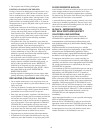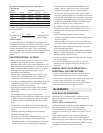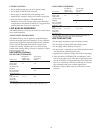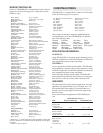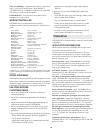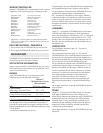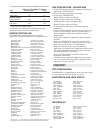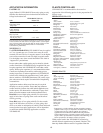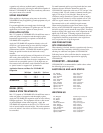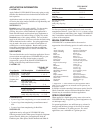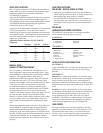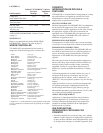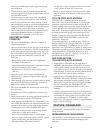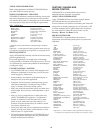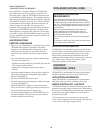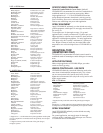
vegetation only after any residual stand is completely
defoliated, at least twice, allowing for sufficient root uptake of
D
uPont™ VELPAR® DF. In the West, results may take one to
two years in areas of low rainfall.
SPRAY EQUIPMENT
When applied as a liquid spray using water as the carrier,
V
ELPAR® DF may be applied by ground equipment or by air
(
helicopter only).
For ground application, use enough water for thorough
coverage, usually a minimum of 25 gallons per acre. For aerial
applications, use at least 5 gallons of water per acre.
GRID APPLICATION
Mix 2 2/3 pounds of VELPAR® DF with sufficient water to
make one gallon of suspension and thoroughly agitate.
Intermittent agitation may be required to maintain the
VELP
AR® DF in suspension.
Apply the VELPAR® DF suspension directly to the soil
surface in a grid pattern using an exact delivery handgun
applicator. This equipment delivers a thin stream of
predetermined volume. VELPAR® DF should be applied
during the period from hardwood bud break to early
summer.
Application rate and grid pattern will depend on soil texture
and woody plant composition. Use the lower rates on
coarse textured soils and when the major component of the
hardwoods are susceptible species. Use the high rates on
fine-textured soils and where weeds identified in this label
as “partial control or suppression” predominate.
Application Patterns and Rates For VELPAR® DF
Suspension
ML/Spot Grid (Ft) Lb/Acre
Coarse
0.6 3 X 3 2
2.0 4 X 4 4
3.1 4 X 6 4
Medium/Fine 1.6 3 X 3 5.3
2.8 4 X 4 5.3
3.5 4 X 4 6.6
5.2
4 X 6 6.6
BASAL (SOIL)
SINGLE STEM TREATMENTS
Mix 2 2/3 pounds of VELPAR® DF with sufficient water to
make one gallon of suspension and thoroughl
y agitate.
Apply the VELPAR® DF suspension with an exact-delivery
handgun applicator. This equipment delivers a thin stream
of predeter
mined v
olume when triggered. Apply the
VELPAR® DF suspension at the rate of 2 to 4 ml for each
inch of stem diameter at breast height. Direct the treatment
to the soil within 3 feet of the root collar of woody plants to
be contr
olled.
For multi-stemmed and low-growing brush that have stem
diameters that are difficult to determine, apply the
V
ELPAR® DF suspension at the rate of 2 to 4 ml per 3 feet
of canopy width. For tall, slender (columnar) brush types,
a
pply 4 to 8 ml per 3 feet of height. Base the rate on
whichever canopy dimension is greater (width or height).
Apply the lower volumes for coarse textured soils or soils
with low organic matter soils and the higher volumes for
fine textured soils or soils with high organic matter.
When treating brush that requires more than a single
delivery of the VELPAR® DF suspension, apply subsequent
deliveries equally spaced around the target plant. If treating
brush on sloping sites, apply most of the suspension on the
uphill side of the stem. If treating resprouts from brush
disturbed by cutting or other mechanical methods, the rate
of application should be proportional to the original tree
size, not just the size of sprout regrowth.
USE PRECAUTIONS
SITE PREPARATION
Where burning is desired, burn the vegetation only after any
residual brush has completely defoliated, at least twice,
allowing for sufficient root uptake of VELPAR® DF.
Following harvest, allow sufficient time for stumps and
injured trees to adequately resprout before applying
VELPAR® DF.
FORESTRY – RELEASE
VELPAR® DF is recommended for conifer release where
the following species are grown:
EASTERN US AND LAKE STATES
WESTERN US
Fir, Douglas Pseudotsuga menziesii
Fir, grand Abies grandis
Fir, Noble Abies procera
Fir, white Abies concolor
Hemlock,Western Tsuga heterophylla
Pine, Jeffrey Pinus jeffreyi
Pine, lodgepole Pinus contorta
Pine, ponderosa Pinus ponderosa
Spruce, blue Picea pungens
Spruce, Englemann Picea englemannii
Spruce, Sitka Picea sitchensis
Fir, balsam Abies balsamea
Pine, loblolly Pinus taeda
Pine, longleaf Pinus palustris
Pine, red Pinus resinosa
Pine, shortleaf Pinus echinata
Pine, slash Pinus elliotti
Pine, Virginia Pinus virginiana
Spruce, black Picea mariana
Spruce, Norway Picea abies
Spruce, red Picea rubens
Spruce, white Picea glauca
14



